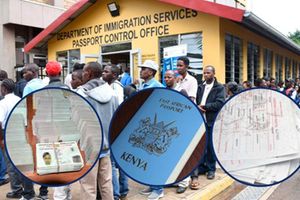Kenya wants China to pay half the cost of SGR extension to Kisumu

President Uhuru Kenyatta (left) with President of the People's Republic of China Xi Jinping at the opening session of the The Forum for Africa-China Cooperation, 2018 FOCAC Summit in Beijing, China. PHOTO | FILE
What you need to know:
The Standard Gauge Railway's first phase from Mombasa to Nairobi was completed last year at a cost of Sh327 billion.
If China provides a Sh190 billion grant, Beijing will not demand pay could still squeeze in a deal to ensure the Chinese firms benefit from the project.
President Kenyatta told China that the construction of the railroad should have, as a by-product, improved human skills and training.
Kenya wants Beijing to foot half of the cost of extending the Standard Gauge Railway (SGR) to Kisumu, in what could be the latest move by Nairobi to slow down on debt.
During a bilateral meeting with China’s Xi Jinping, President Uhuru Kenyatta indicated that the cost of the 270km extension should be split into a loan and a grant to relieve the country.
A source in the Presidency privy to the discussions said the President wants China to arrange the financing, but only as long as Nairobi pays just half the cost.
“The Naivasha-Kisumu phase of the SGR will cost $3.8 billion. And owing to its regional significance, I would request that 50 per cent of its cost be provided as part of grant financing,” President Kenyatta told his host.
The meeting, the third on Chinese soil, was expected to secure financing deals for infrastructure.
RESPONSIBLE BORROWING
But facing critics back home for alleged irresponsible borrowing, President Kenyatta’s bid, if accepted by Beijing, could mean taxpayers will foot only half of the estimated Sh380 billion railroad.
The President was telling his host about Nairobi’s readiness to play into China’s Belt and Road Initiative, President Xi’s policy vision to connect Eurasia, Africa, Europe and the Americas through trade and infrastructure.
The Standard Gauge Railway, whose first phase from Mombasa to Nairobi was completed last year at a cost of Sh327 billion, is supposed to pass through Kenya, Uganda, Rwanda and the DRC. It is part of China’s long-term vision to access resources in the interior of Africa.
OPENING CHINA
“The SGR sits very well on the Belt and Road Initiative. It commences the envisaged land bridge between the Indian and Atlantic Oceans, opening up the interior for trade and investment across seven countries, and opening China to Central Africa, and further on, beyond the Atlantic Ocean,” the President said.
If China provides a Sh190 billion grant, Beijing will not demand pay could still squeeze in a deal to ensure the Chinese firms benefit from the project.
But President Kenyatta told his host that the construction of the railroad should have, as a by-product, improved human skills and training.
The Mombasa-Nairobi SGR route is operated by Chinese firm China Road and Bridge, even as Kenyans repay the loan. The Chinese are also completing the second phase from Nairobi to Naivasha at a cost of Sh150 billion.
SH5.1 TRILLION DEBT
But with public debt reaching Sh5.1 trillion, President Uhuru Kenyatta’s delegation also proposed a change in the public private partnership (PPP) in financing for other infrastructural projects. PPP might prevent the public from choking under a huge repayment bill, but critics say the projects might actually cost more as the financiers recoup their money operating them for some time.
For example, Kenya secured a PPP deal to build a 30-kilometre expressway from the Jomo Kenyatta International Airport to Westlands in Nairobi.
The road is to be financed by China, but Beijing will do the tolling until it recoups its money.
The President has been attending the 7th Summit of the Focus on China-Africa Cooperation (FOCAC), a three-yearly conference where Beijing meets African leaders.





